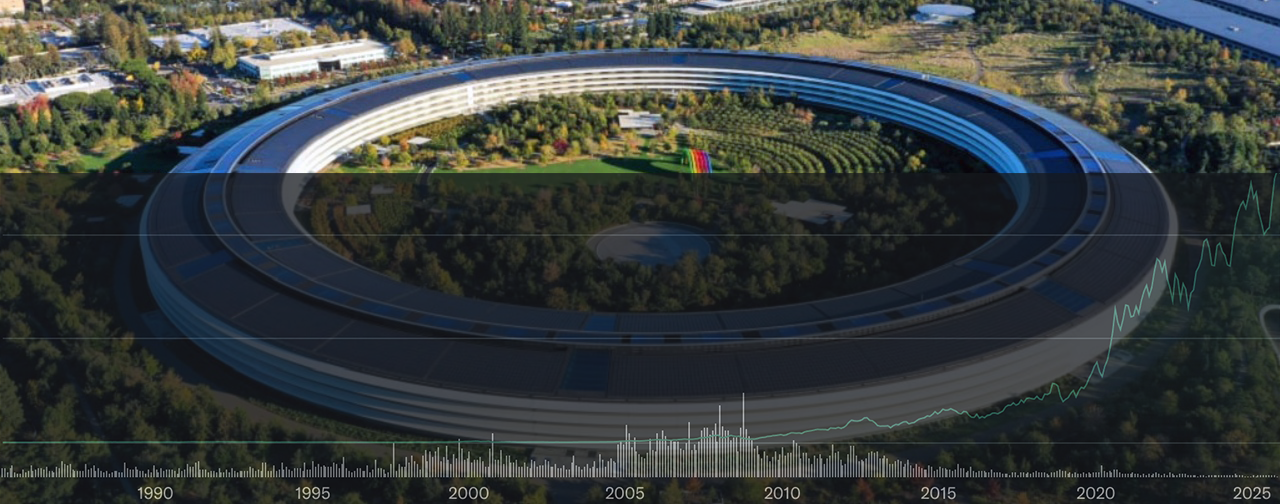What is also working against AAPL in terms of its share price being more in line with all of these financial metrics is its total market capitalization. The conventional thinking is that it will be difficult for the company to continue growing its bottom line at the pace it has been on due to the average of large numbers. It’s sort of like trading on the technicals; price targets becomes a self-fulfilling prophesy. This line of latent thinking however is why I’ve remained invested in the stock because eventually, fundamentals have to take over. The company has managed to create a broad ecosystem ranging from an inexpensive device called the iPod shuffle to an impractical and extremely expensive for most users, 12-core workstation in the Mac Pro. For the most part, these devices are also aesthetically pleasing with their industrial design. The company also creates the key software which runs on the majority of these devices as well the “glue” of online services which bind them together. For the average consumer, Apple’s offerings tend to fit the bill (and yes, for those of us on the niche fringe, there can be some frustration mixed in with the design and engineering decisions but that is a different story which will be posted very soon) and they are the larger demographic. And like it or not, market share is one of those metrics; a fundamental to being able to be the 800 pound gorilla in the room which can influence everything from component pricing to getting the best terms when negotiating some business deals (and yes, I’m oversimplifying the reality because this is not a financial blog).
One of the important “glues” is of course the App Store since there is a threshold where once someone has invested a certain monetary amount in the apps they’ve purchased, makes them pretty much a sticky customer where it requires something far better to get them to switch away from what they are currently using (including ditching their investments in apps). For long time Windows users, that aspect (of the apps they purchased and used) was a key impediment to realistically switching to the Mac before Apple made the transition to Intel processors (that plus Bootcamp as well as the ability to use virtualization software on Intel-based Mac’s provided a way for such users to continue utilizing their application investments while also gradually providing a means to fully transition to Mac equivalents).
A portion of this customer base also ends up becoming captive where their decision becomes a lifestyle choice. If you look around today, it is hard not to see an Apple product around. Just 5 years ago, the story was much different. Go back 10 years, and if you were out in public with say a PowerBook, you were considered one of those “fanatics” (something which I took personal offense with because I’ve never fit into the Apple/Mac fanatic category) and often times smirked upon or looked at like you had some sort of disease. I also am fully aware that the general consumer can also be very finicky where their allegiance can turn on a dime IF the company makes the wrong choices. While the company has in recent times has had its share of supposed gaffes (antennagate, the stance on Flash, Final Cut Pro X, just to name a few), they aren’t big enough to have any serious impact on the majority of general consumers who do not keep up with all of these sort things on a daily basis like the techie crowd or the company fan boys/girls.
iOS apps come in two forms; ones which run on just iPhones and/or iPod touches or iPad’s, and “universal” ones which run on all. One day down the road, it isn’t hard to envision where the lines will really blur between iOS and Mac OS X. That will also go for a subset of applications which could one day scale from the desktop all the way down to the iPhone/iPod touch form factor making the entire ecosystem that much more sticky (and from the customer perspective, a better total cost of ownership value). But this is my personal 5 year vision of where I think the company is heading towards and not necessarily what company executives have planned. Additionally, what isn’t factored in are other ways which Apple could utilize their operating system code base. Apple TV is still a hobby to the company though it is quite clear to me that software and services will eventually change the overall value of the device. The idiotbox (what most folks call the television set) is one of those last bastions in the home but as Jobs once said, that is a tougher nut to crack because of the business model.
Which leads me to constantly recurring rumor that Apple will one day actually release their own branded HD television set. The pieces are actually there but in individual pieces (iMac, Apple TV, Mac mini) where the relevant parts would need to be taken from each. The most complex part though would be the “firmware” which makes the television functionality easy and further hides the “complexity” of iTunes and the App Store by presenting functionality in an easy to use format that any non-technical couch potato can quickly grasp. I know people who have difficulties setting their DVD recorders or their digital set top boxes because of their really craptacular user interfaces. I also know people who have trouble using computers period including a Mac. But these same people are able to eventually master an iPad. Therefore, I know that if anyone can make the idiotbox near idiotproof, it is Apple. But that is the technology side. The tougher part is content (in terms of licensing deals). And that leads to what I believe needs to take place to make an Apple branded television set more of a realistic reality; that more consumers move away from the forced push environment of cable TV to more of the pull/on demand environment like that offered by Apple and Amazon (as well as others). That is a big challenge because of the way most folks brains are wired when it comes to perceptions of how television should work. Is that way of thinking eroding? Yes, because as Apple (and other companies) sell more of these “on the go” devices which utilize app stores and music stores to get their content, then it becomes easier and 2nd nature for people to move past the old way of watching their content. Media providers will have to adapt to that new reality if they want to stay in the game (like how CNN has started offering live streams or how Japan’s NHK has been doing this with some of their broadcasts for several years now).
While it seemed like this went off on a tangent, the point is that there is quite a bit of legs in the iOS platform which could provide new avenues of revenue streams for Apple. Let me also be clear that I am in no way advocating anyone to go out and buy Apple stock either as that requires performing far more personal due diligence that I can offer on a non-financial blog; not making some decision based on what some unknown person is consciously streaming on a site like this (and that also goes for some of the pontifications that take place on well known financial sites; with one of the biggest offenders being CNBC). Furthermore, everyone has their own personal risk tolerance and financial situations which determines whether or not they put their money in the market (and one should only invest what they can afford to lose). What I wrote are some reasons why I’m personally invested in this stock for at least the next 5-10 years, though my nearer term horizon has always been to begin divesting myself starting around 2015 to being actually realizing what are essentially just gains on paper. I’ve also mentioned that my crystal ball has often times been very defective (cracked and foggy) so I have little idea whether or not the company will actually do some of the things I think they might do let alone, being able to know where the stock will be 5-10 years from now. If did, I’d be fully retired now and coasting along like Guy Kawasaki. One thing I do know is that when the company has executed, the returns on my original investments have over the long term, done quite well. But getting from point A (1997) to B (the present) has not always been easy and often time required having fortitude to stick it out (and much of that was because my tolerance to risk was high and that when AAPL had lost over 80% of its value after the WTC attacks and resulting recession, locking in the paper losses by actually selling made little sense since I didn’t believe the company would go all the way to 0 from there).



